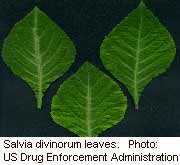
TUESDAY, Jan. 4 (HealthDay News) — After a video surfaced on the Internet last month of pop star Miley Cyrus — giggling and semi-coherent, holding a bong — many wondered what the 18-year-old singer had inhaled.
According to Cyrus, her addled state was the effect of taking in smoke from the leaves of the Salvia divinorum plant, including its active ingredient, a potent hallucinogen called salvinorin A.
The plant (one of the mint family of herbs) has been used for centuries for spiritual healing by shamans living among the Mazatec people of Oaxaca, Mexico. But in recent years the drug has been discovered by a new crowd — young Americans seeking a legal high.
“When people are on this drug they’re not acting like they’re in this world.” said Dr. Matthew W. Johnson, lead author of the first study to explore the effects of salvinorin A on volunteers.
“People report almost instantaneously being transported to a completely different reality,” said Johnson, who is scientific and assistant professor in the department of psychiatry and behavioral sciences at John Hopkins University School of Medicine in Baltimore. “Some people describe it as being in another dimension, during which they have highly elaborate interactions with so-called ‘entities’ that are not of this world.”
According to the study, salvia prompts an almost immediate and extremely powerful reaction among users. The experience, which typically lasts five to 15 minutes, is not accompanied by any appreciable health risks in the short-run, the researchers found.
“But that’s not to say that I would generally describe this drug as ‘safe,'” Johnson cautioned. He said that taking any hallucinogen “means that if someone was to smoke it while driving, my money would be on the likelihood that they are going to have an accident. So there is certainly a ‘behavioral toxicity’ concern with this drug.”
The study, funded by the U.S. National Institute on Drug Abuse, was published in the current online issue of Drug and Alcohol Dependence.
The widespread publicity given to salvia after the Miley Cyrus incident has driven up interest in the drug. In fact, The New York Times recently reported that Google searches for salvia jumped some 600 percent following public postings of the Cyrus escapade.
By trying it out in Los Angeles, however, Cyrus broke no law, since regulations regarding the substance vary state by state, and California currently has no prohibition in force. Salvia is banned in 13 countries and 15 states in the U.S, and for the moment it remains easily accessed online and in American head shops in jurisdictions where it is legal. The U.S. Drug Enforcement Administration currently labels salvia a “drug of concern” instead of a controlled substance.
Johnson’s study focused on two men and two women who all said they typically tried to be both mentally and physically healthy. However, all had reported having taken other hallucinogens in the past, such as LSD, mescaline, and/or “magic” mushrooms, although the authors note that salvinorin A does not actually stimulate the same serotonin receptors as those other substances.
Each volunteer participated in 20 lab sessions (lasting about 2.5 hours) that were spread across an eight to 14-week period. During that time, a total of 16 doses of pure salvinorin A were administered via smoking, with higher doses being given in succession, sometimes interspersed with sugar pills (placebos) that were randomly inserted into the regimen.
The participants themselves reported that the drug “hit” within seconds of inhalation, prompting an extreme disorientation that peaked in strength at about two minutes post-ingestion. After 20 minutes, however, the drug’s effects had pretty much worn off.
While under its influence, users described the impact as strong and intense, provoking a dysphoria (anxiety, unease) and a sense of disconnection from reality.
Luckily, there seemed to be no impact on health, at least in this setting and in the short-term. Johnson and his colleagues found no evidence of meaningful heart rate or blood pressure variations as a result of use.
The researchers concluded that in the kind of controlled environment in which it was tested the drug appeared to be safe.
“This is also not a drug of addiction, and there’s no indication so far of any mechanism that would cause some type of lethal overdose,” Johnson added. “Insane doses have been given — at doses many, many times higher than what we gave people — and there’s a remarkable absence of lethal toxicity. And we’re not seeing a lot of emergency room visits with this drug, probably because although it’s so impairing it’s also such a short-lived experience.”
However, because of the intensity of the experiences provoked by salvia, and its very short duration, it’s also not likely to be a repeat event for many users, Johnson said.
Speaking to the Times, Lee, a 22-year-old from New York City who requested anonymity, said he tried salvia while in college. “After two or three hits, I spat everywhere and was coughing and laughing and drooling,” he said. “I started yelling random words, then my legs gave out, and I dropped to the floor.”
Dr. Bryan Roth, a psychiatrist and a professor of pharmacology at the University of North Carolina at Chapel Hill, agreed that salvia might be a one-hit wonder for most who try it.
“The experience is likely to be very intense and most people who are taking it are not psychologically prepared for this type of experience,” he explained. “The typical college or high school student who’s experimenting with this stuff will likely find it bewildering, disorienting and frightening.”
More information
For more on salvia, visit the U.S. National Institutes of Health.

